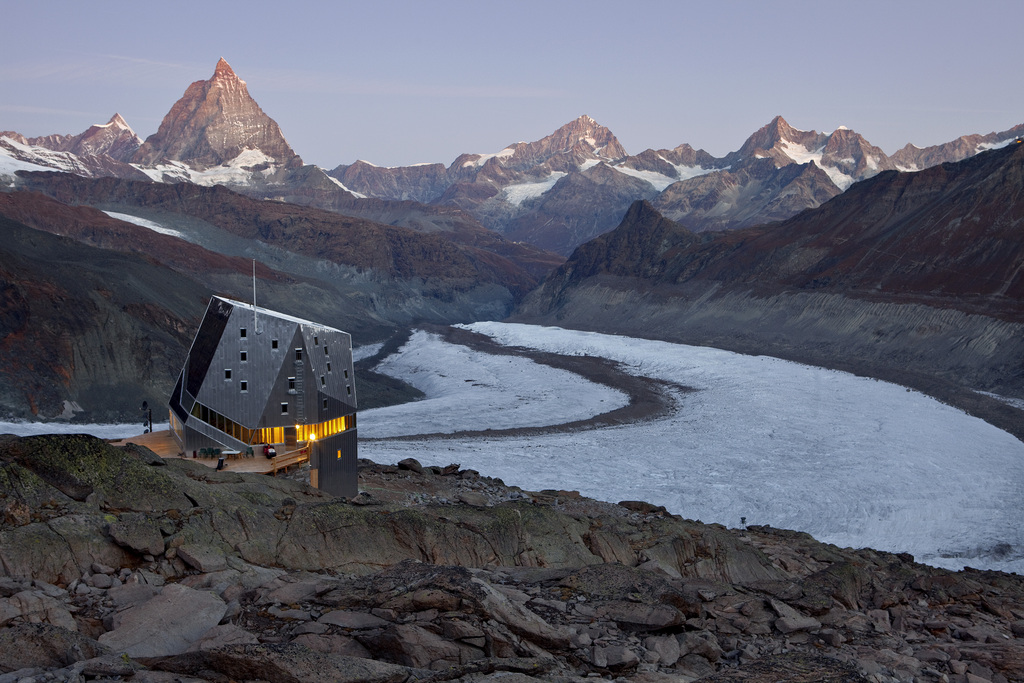
Alpine huts face paradoxical water shortage

Melting glaciers and rising guest expectations are straining the water resources of the Swiss Alpine Club’s (SAC) mountain huts beyond their limit despite being surrounded by glaciers and streams.
Many hut managers can only dream of the cliché of copious amounts of fresh, cool water gushing forth from picturesque alpine rocks. Reality provides a very different picture, with managers often struggling to save drinking water.
“Water scarcity is on the rise,” says Hans Rudolf Keusen, a geologist and natural hazards specialist. “A lasting solution to the problem will be costly.”
The SAC, on the eve of its 150th anniversary, faces a formidable task.
Huts across the Alps are affected by this phenomenon, according to Andrea Hess, co-president of the SAC’s central hut commission.
“The problems are different for each hut,” says Hess. “For the 152 huts that the SAC officially manages, there are probably different solutions needed for each one.”
Some of the “huts” are more akin to small hotels and in high demand.
In addition to retreating glaciers and diminishing supplies of meltwater, increasing demand from users has sped up the water crunch.
“As huts are modernised, they are fitted out with showers, dishwashers, and flush toilets,” explains Keusen. But their modern ambience and quality food can lull their guests into believing they are in the middle of civilisation.
Existing water systems have been cobbled together though and are inadequate, compounding the problem according to the geologist.
Victims of success
The Lämmeren hut in the Bernese Alps with 100 beds is a case in point. Among the busiest SAC huts, it also has one of the largest water requirements.
Its owners, an SAC section in canton Basel Country, are planning an extension to answer rising demand in the coming years.
Keusen says the Lämmeren hut’s future water supply could look something like this: a catchment in a stream with seepage pipes for clean water, a tank for water storage and a small power station with a turbine.
Guaranteeing an adequate water supply would cost between SFr100,000 ($102,000) and SFr120,000, a figure that does not include extra funding for the power station and other building services.
“But in view of the fact that the addition would cover capacity for the next 25 years, the cost-benefit ratio is acceptable,“ reckons Keusen.
Because the temperature in the huts dips way below zero in winter, guaranteeing water supply water during that time is particularly difficult.
Experts say that reservoirs with a capacity of up to 300,000 litres of water are best suited to bridge this gap.
Reservoirs are also seen as the solution for smaller huts such as the 3000-metre-high Weisshorn hut in the Valais Alps, which is only visited by a small number of experienced climbers.
The water supply for these huts would be taken directly from glaciers.
“Because glaciers are melting so fast, the pipes for the water catchment would need to be constantly extended,” points out Keusen, who also recommends creating small reservoirs.
Taking stock
In most cases neither the relevant SAC section nor the central hut commission know what future water requirements might be. A survey of the current water supply situation of all 152 SAC huts is underway, which should provide an overview by the middle of next year.
“We will have a clearer idea of how the situation in Switzerland looks only after we’ve done the inventory,“ says Keusen, who is also a member of the central commission.
Increased competition for guests and profits has led to another change over the past decades, with a new focus on passing trade.
As the example of the Lämmeren hut shows, this strategy has paid off.
Hess says that managers who have families have had to learn to think in business terms as well as ecologically.
The much-needed modernisation of water supplies is just one element. Managers now need to convince their guests to use water sparingly, either by explaining the water situation to guests, or by posting information sheets according to Hess.
“It can lead to a real insight when visitors realise how much work is involved in making water available in a mountain hut,” he adds.
The 152 SAC huts are owned by 105 SAC sections.
In 2011 there were over 335,000 overnight stays in the huts, 0.6% less than in the previous year. There are about 9,200 beds.
Turnover amounted to SFr26.8 million in 2011 (SFr19.4 million from food and beverage sales, and SFr7.4 million from overnight stays).
While additions and new construction are the responsibility of the sections, the SAC central hut commission has to approve all projects.
The sections pay for 75% of costs for extensions and new construction. The central hut commission contributes the remaining 25%.
Hans Rudolf Keusen has recommended professional solutions for ensuring water supply to SAC mountain huts.
In the case of the Lämmeren hut, the first priority is planning for future water needs. Keusen estimates 20 to 50 litres is needed per overnight stay, and ten litres for day trippers.
After ascertaining the basic needs of the hut, he scouted the surroundings to determine the ideal location for a new water supply.
He decided upon a low debit area in the same stream that is often used today, but which can be polluted by animals. The low flow area is ideal for a seepage pipe connection.
Clean water can be stored in a tank for use at any time.
He also suggested a mini-power plant with a small turbine for the sizable Lämmeren hut, to ensure that basic energy needs can be reliably met.
(Translated from German by Kathleen Peters)

In compliance with the JTI standards
More: SWI swissinfo.ch certified by the Journalism Trust Initiative































You can find an overview of ongoing debates with our journalists here . Please join us!
If you want to start a conversation about a topic raised in this article or want to report factual errors, email us at english@swissinfo.ch.